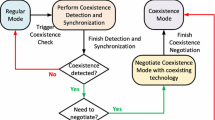Abstract
Unlicensed spectrum is increasingly being used by mobile operators to meet the mobile traffic demand, and Wi-Fi is foreseen as one of the technologies for implementing mobile traffic offloading. However, Wi-Fi efficiency does not scale well as node density increases, and IEEE 802.11ax Task Group (TGax) was created in 2014 for developing Wi-Fi technology enhancements in dense deployments. This paper investigates Wi-Fi performance in the presence of Overlapping Basic Subscriber Set (OBSS) Wi-Fi networks in indoor dense deployments. We observe that Wi-Fi could benefit from scheduled operation with proper OBSS interference coordination. We propose a novel distributed interference coordination scheme for Wi-Fi scheduled mode operation, and evaluate it through system-level simulations. Results indicate that the proposed scheme provides significant improvements over Enhanced Distributed Channel Access (EDCA) for downlink (DL) traffic.









Similar content being viewed by others
References
Cisco. Global mobile data traffic forecast update, 2014–2019. White paper, Cisco Visual Networking Index (VNI) (February 2015).
Markendahl, J., & Makitalo, O. (2010). A comparative study of deployment options, capacity and cost structure for macrocellular and femtocell networks. In Personal, indoor and mobile radio communications workshops (PIMRC Workshops), 2010 IEEE 21st international symposium on, Sept 2010, pp. 145–150.
Frias, Z., & Perez, J. (2012). Techno-economic analysis of femtocell deployment in long-term evolution networks. EURASIP Journal on Wireless Communications and Networking, 2012(1), 1–15.
IEEE, Part 11: Wireless LAN medium access control (MAC) and physical layer (PHY) specifications, Amendment 4: Enhancements for very high throughput for operation in bands below 6 GHz. IEEE Standards Association, Tech. Rep. IEEE 802.11ac, (2013)
3GPP, Feasibility on licensed-assisted access to unlicensed spectrum (Release 13). 3rd Generation Partnership Project (3GPP), Tech. Rep. 3GPP TR 36.889 V0.3.1, (February 2015).
LTE-U Forum, LTE-U SDL coexistence specifications. LTE-U Forum, Specification v1.0, (February 2015).
Q. Intel Corporation, China Telecom, LTE-WLAN radio level integration and interworking enhancement, 3GPP RAN2, work item description RP-150510, (March 2015).
Kleinrock, L., & Tobagi, F. A. (1975). Packet switching in radio channels: Part I-carrier sense multiple-access modes and their throughput-delay characteristics. IEEE Transactions on Communications, 23(12), 1400–1416.
Abinader, F. M., Jr., Almeida, E. P. L., Choudhury, S. et al. (2014). Performance evaluation of IEEE 802.11n WLAN in dense deployment scenarios. In 2014 IEEE 80th vehicular technology conference (VTC2014-Fall).
Wang, L., Lan, Z., Kang, H., Fang, Y., Stacey, R. et al. (2014). IEEE 802.11ax functional requirements. IEEE 802.11 WG, IEEE 802.11 TGax document IEEE 802.11-14/1009r02.
Baid, A., & Raychaudhuri, D. (2015). Understanding channel selection dynamics in dense Wi-Fi networks. IEEE Communications Magazine, 53(1), 110–117.
Geier, J. (2004). Assigning 802.11b access point channels. Wi-Fi Planet, Tech. Rep.
Wang, X., Lou, H., Ghosh, M., Zhang, G., Xia, P., Oteri, O. et al. (2014). Carrier grade Wi-Fi: Air interface requirements and technologies. In Systems, applications and technology conference (LISAT), 2014 IEEE long island, May 2014, pp. 1–6.
Merlin, S., Barriac, G., Sampath, H., Cariou, L., Derham, T., Rouzic, J.-P. L. et al. (2014). IEEE 802.11ax simulation scenarios. IEEE 802.11 WG, IEEE 802.11 TGax document IEEE 802.11-14/0980r10.
Safavi-Naeini, H.-A., Tuomaala, E., Alanen, O., Choudhury, S., Rantala, E., & Kneckt, J. (2014). Adapting CCA and receiver sensitivity. IEEE 802.11ax Task Group (TGax), Presentation IEEE 802.11-14/1443r0.
Soder, J., Mestanov, F., Wilhelmsson, L., Persson, H., Agardh, K., Carney, B. (2014). UL & DL DSC and TPC MAC simulations. IEEE 802.11ax Task Group (TGax), Tech. Rep. IEEE 802.11-14/0868r0
Chaves, F. S., Cavalcante, A. M., Almeida, E. P. L., Abinader Jr., F. M., Vieira, R. D., Choudhury, S. (2014). Adaptive transmit power for Wi-Fi dense deployments. In 2014 IEEE 80th vehicular technology conference (VTC2014-Fall). Institute of Electrical and Electronics Engineers (IEEE).
Deng, D.-J., Chen, K.-C., & Cheng, R.-S. (2014). IEEE 802.11ax: Next generation wireless local area networks. In: Heterogeneous networking for quality, reliability, security and robustness (QShine), 2014 10th international conference on, August 2014, pp. 77–82.
Asai, Y. (2014). Advanced progress in IEEE 802.11 WLAN standardization. In Microwave conference (APMC), 2014 Asia-Pacific, November 2014, pp. 911–913.
Kosek-Szott, K., Natkaniec, M., Szott, S., Krasilov, A., Lyakhov, A., Safonov, A., et al. (2013). What’s new for QoS in IEEE 802.11? IEEE Network, 27(6), 95–104.
Porat, R., Fischer, M., Merlin, S., Vermani, S., Au, E., Yangxun, D., Zhang, J., Luo, J., Pang, J., Stacy, R., Azizi, S., Ghosh, C., Lee, W. et al. (2015). IEEE 802.11ax evaluation methodology. IEEE 802.11 WG, IEEE 802.11 TGax document IEEE 802.11-14/0571r08.
Author information
Authors and Affiliations
Corresponding author
Additional information
Fuad was with INDT at the time this paper was submitted.
Rights and permissions
About this article
Cite this article
Abinader, F.M., Choudhury, S., de Sousa, V.A. et al. Distributed Wi-Fi Interference Coordination for Dense Deployments. Wireless Pers Commun 97, 1033–1058 (2017). https://doi.org/10.1007/s11277-017-4550-3
Published:
Issue Date:
DOI: https://doi.org/10.1007/s11277-017-4550-3




